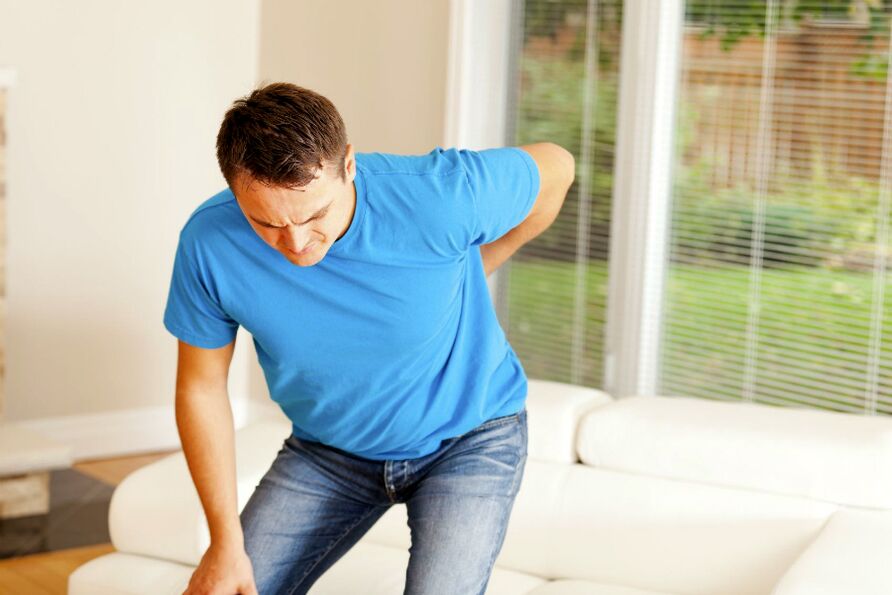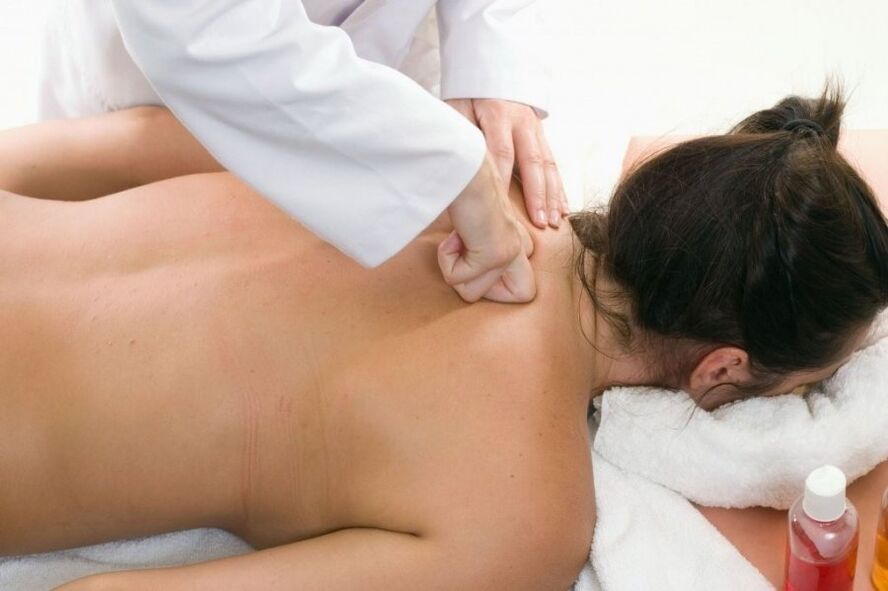
Complaints about back pain are one of the most common reasons for seeing a doctor. Pain in this part of the body can be a sign of normal fatigue from excessive physical exertion, or it can indicate a serious health problem that requires proper treatment.
Back pain is an unpleasant manifestation of many ailments or other causes of overworked back muscles.
In most cases, this pathology occurs in the context of various changes in the structure of the spinal joints and adjacent muscles, nerve endings, or spinal skin. In addition, this symptom is accompanied by disease or dysfunction of some internal organs.
Causes of Back Pain
The back can be injured if there are any of the following lesions:
- spine;
- musculoskeletal devices;
- internal organs.
Muscle pain due to heavy physical exertion can also occur in healthy people.
Spine Pathology
In addition, common spinal conditions in which pain syndromes occur were considered.
osteochondrosis
Osteochondrosis is the most common answer to the question: "Why does my back hurt? " With this pathology, the intervertebral cartilage degenerates, the cartilage thins, the space between the vertebrae shrinks, and nerve roots can become pinchedlive. For pain in osteochondrosis, the following symptoms are characteristic:
- Occurs during or after physical activity, and prolonged periods of inactivity;
- May have a shooting or pain disposition;
- Exercise makes the pain worse.
If sciatica is caused by pinching the sciatic nerve, the pain occurs in the buttocks, radiating from the back along the surface of the thigh. Sensitivity (numbness, tingling, burning) may be violated. With low back pain, there is often a shooting or throbbing pain that causes the patient to freeze completely in place. Patients complained that they shot or sprained their backs.
Injuried
Injuries are more common in a fall (on ice, when exercising) or from a backstroke in a traffic accident. Pain can lead to bruising and more serious injuries -- fractures and dislocations of vertebral bodies. Pain at injury may be of the most diverse nature:
- pain,
- combustion,
- shooting,
- stupid.
Depending on the nature and location of the injury, the pain sensation may be constantly interfering, occur with certain movements, or feel pulsatile. It is important to know that serious injuries are not always caused by heavy hits.
For example, spinal compression fractures in older adults may be caused by mild mechanical loading without much damage to the vertebrae during the first day after the injury. In the future, if immobilization and treatment measures are not taken, the pain will worsen and may damage the nerves and spinal cord.
At first glance, any spinal injury, even minor, requires a doctor's examination.
intervertebral hernia
An intervertebral hernia is a herniation of a fragment of a disc into the spinal canal. Hernias are usually the result of degenerative changes in the spine, or the result of an injury. A herniated disc can occur anywhere in the spine, but is more common in the lower back, as it is the person who bears the main load.
In the initial stages of hernia formation, back pain is caused by physical activity, occurs from time to time, and is less intense. As the disease progresses or there is a dramatic loss of disc fragments, the pain can be very severe, and shooting occurs naturally when the leg is irradiated.
Often, patients complain of numbness or burning in the problem area and in the lower or upper extremities. This suggests that there is an invasion of nerve endings. Severe pain can cause muscle spasms that can lead to incorrect posture, pathological kyphosis or lordosis.
Spinal curvature (kyphosis, lordosis, scoliosis)
As the spine curves, in order to compensate for the pathological curvature, significant muscle tension occurs, resulting in frequent and sometimes persistent dull pains in the back.
Muscle pain
85% of cases of chronic or recurring pain in the back muscles are related to excessive stress in the lower back. Even for those who don't take on a lot of exercise loads and don't carry heavy loads, the back muscles can feel tense on a daily basis. This is especially true for long-term static loads during sedentary computer work.
Unheated muscles can easily be injured when making sharp turns, lifting heavy objects, or performing inappropriate movements. Pain may be due to an inflammatory disease of the muscle (myositis) or due to severe stress, causing reflex spasms of muscle fibers.
infectious disease
Tuberculosis most commonly affects the spine. In the vertebrae, the infection penetrates the hematogenous (through the blood) pathway and causes inflammation, which then leads to osteonecrosis. Lumbar and thoracic pain are characteristic signs of spinal tuberculosis, and half of the patients present with neurological symptoms—numbness and weakness in the extremities.
In addition, common presentations are characteristic of spinal tuberculosis:
- weakness,
- sweating,
- elevated body temperature,
- rapid fatigue,
- no appetite.
tumor disease
In most cases, the spine itself does not develop a malignant tumor. Cancer cells get here through blood or lymph from other lesions. Most often, spinal metastases lead to breast, lung, and prostate cancer. At first, the pain may resemble that of common osteochondrosis, but then the back pain is constant and increasing in intensity.
Pain is not always relieved with traditional pain relievers; only the introduction of narcotics can relieve pain. With multiple metastases, the pain is mobile in nature, covering different parts of the spine. In addition to back pain, patients experience weakness, unreasonable weight loss, and fever to low-grade fever. Unfavorable prognosis.
Gastrointestinal disease
The most common back pain occurs with pancreatitis. It is surrounded by nature and is very intense. In acute pancreatitis, pain may be accompanied by a drop in blood pressure and loss of consciousness. Acute pancreatitis is an indication for emergency admission to a surgical hospital.
In addition to pancreatitis, pain can radiate to the back, with episodes of peptic ulcer or biliary colic.
Genitourinary system diseases
Kidney disease, especially urolithiasis, often causes lower back pain during exacerbations. If there is pain in the lower back, the pain is accompanied by dysuria or in the groin area, a consultation with a surgeon is required, and women need to be examined by a gynecologist to rule out inflammation of the adnexa or the presence of an ectopic pregnancy.
Pregnant woman with back pain
Pregnant women often complain of a broken or painful back and lower back, especially in the later stages. This is because in the second half of pregnancy, the load on the lower back muscles increases due to the significantly enlarged uterus and the shifting of the center of gravity. The pain is usually dull and worse with changes in body position, especially when standing up from a chair or armchair.
What to do if you have back pain
If you have back pain for more than three days, you should consult your doctor. Seek immediate medical attention if your back pain is accompanied by:
- poor general health;
- a drop or a sharp rise in blood pressure;
- increased body temperature;
- Dysfunction of any internal organ.
Also, if the pain is preceded by an injury or severe pain, you will need to seek medical attention.
diagnosis
In most cases, a doctor will be able to make an initial diagnosis during an initial examination. However, to determine exactly what causes back pain, additional research must be done. In most cases, these are X-rays, computed tomography (CT) of the spine, magnetic resonance imaging (MRI) in two projections.
If necessary, a doctor may prescribe general blood and urine tests, an electrocardiogram, an ultrasound of the abdominal cavity or small pelvis, and pictures of the lungs. Tests must be done because even the most severe disease, detected at an early stage, has a good prognosis with proper treatment.
treat
How to get rid of low back pain, only a doctor can recommend based on examination data and examination results. Main principles of treatment: elimination of severe pain and inflammation, effects on the causes of pain, rehabilitation measures (physiotherapy, exercise therapy, massage, proper nutrition) aimed at accelerating the process of tissue regeneration and returning to normal life.
How to relieve pain
To reduce pain, physical activity needs to be limited first. Among pharmacological drugs, non-steroidal anti-inflammatory drugs are most commonly prescribed. These drugs can be taken as tablets or injections, and they are also included in topical ointments. Back pain caused by muscle spasms is treated with warm ointments, alcohol compresses, and warm baths. For severe cramps, muscle relaxants are prescribed.
It is important to remember that any thermal surgery is contraindicated in the first day after inflammatory disease and injury of the internal organs. They lead to deterioration of health and progression of pathology. After eliminating the acute manifestations of the disease, physiotherapy procedures, massage and therapeutic exercises are prescribed. If a pregnant woman has back pain, it is not advisable to use medication.
Wearing special bandages and limiting physical activity will help pregnant women with back pain relief.
physiotherapy
Exercise therapy (therapeutic gymnastics) is the basis for successful treatment of any area of back pain. A set of exercises can be recommended by a physical therapy exercise specialist or a rehabilitation doctor. The class begins with simple exercises that gradually increase the load on the muscles and ligaments of the back and lower back.
This strengthens the muscular corset that supports the spine, adjusts posture, activates blood circulation and metabolism in the tissues, and improves overall health and mood. Treating the back with medication without regular exercise therapy and proper nutrition is illiterate. This will only have a temporary effect.
physiotherapy
Procedures such as light therapy with medication, magnetic therapy, and laser therapy will help speed recovery. During remission, mud therapy and paraffin therapy are effective.

prevention
To avoid back pain, it is important to maintain a healthy lifestyle, including:
- a balanced diet with adequate vitamins and minerals;
- maintain a normal weight;
- regular physical education classes aimed at strengthening the back and abdominal muscles;
- Seek medical treatment in a timely manner when a disease occurs.
Back pain requires mandatory diagnosis to determine its cause and long-term treatment, mainly based on changes in the patient's lifestyle. In the acute phase of the disease, the patient is assisted by pharmaceutical preparations. If you follow all your doctor's recommendations, the prognosis in most cases is favorable.


















